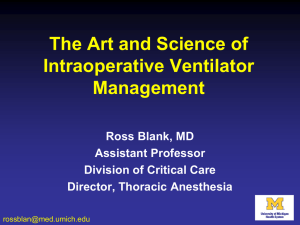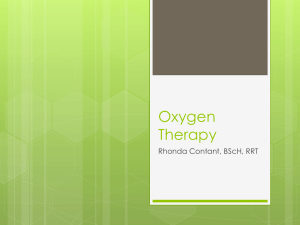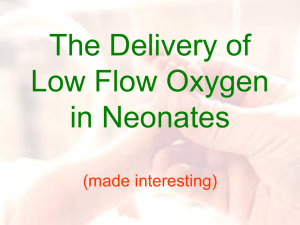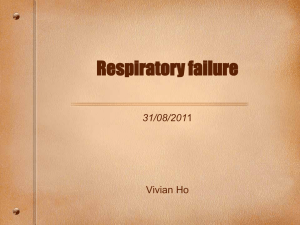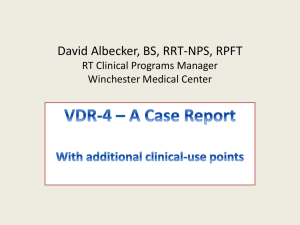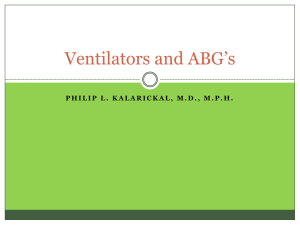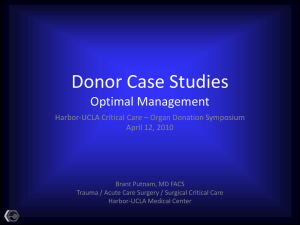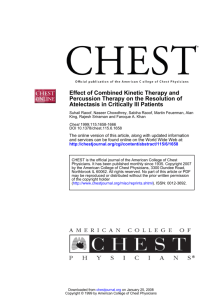oxygen - Tulane University Department of Anesthesiology
advertisement
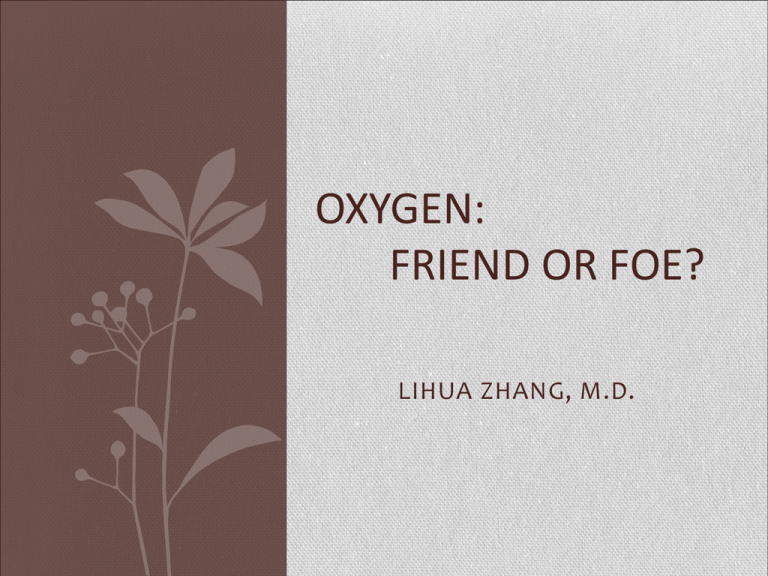
OXYGEN: FRIEND OR FOE? LIHUA ZHANG, M.D. Oxygen is a drug • Oxygen plays a vital role in the breathing processes and in the metabolism of the living organisms. • Oxygen is one of the most widely used therapeutic agents. • It is a drug in the true sense of the word, with specific biochemical and physiologic actions, a distinct range of effective doses, and welldefined adverse effects at high doses. Benefit a high-oxygen strategy could have • oxygen-derived free radicals! • High O2 increase tissue O2 tension • Decrease in surgical site infection? Biologically advantageous uses of Oxygenderived free radicals • killing of bacterial; • killing of malarial parasites; • destruction of circulating tumor cells, particularly in the pulmonary circulation where the oxygen tension is highest. Supplemental Perioperative Oxygen To Reduce The Incidence Of Surgical-wound Infection • Background Destruction by oxidation, or oxidative killing, is the most important defense against surgical pathogens and depends on the partial pressure of O2 in contaminated tissue. An easy method of improving O2 tension in adequately perfused tissue is to increase the concentration of FiO2. • Methods randomly, 500 pts, colorectal resection, FiO2 30% or 80% during the operation and for two hours afterward. GA, abx, wound with culture-positive pus. • Results Among 250 pts with FiO2 80%, 13 (5.2%) had surgicalwound infections, as compared with 28 of 250 pts 30% FiO2 (11.2% P=0.01). The absolute difference between groups was 6%, with a relative risk reduction of 54%. N Engl J Med 2000; 342:161-7 Supplemental Perioperative O2 and the Risk of Surgical Wound Infection A Randomized Controlled Trial • Background Supplemental perioperative oxygen has been variously reported to halve or double the risk of surgical wound infection. To test the hypothesis that supplemental oxygen reduces infection risk in patients following colorectal surgery. • Methods randomly, 300 pts, colorectal resection, FiO2 30% or 80% during the operation and for six hours afterward. GA, abx, wound with culture-positive pus. • Results Among 148 pts with FiO2 80%, 22 (14.9%) had surgicalwound infections, as compared with 35 of 143 pts with FiO2 30% (24.4% P=0.04). The absolute risk reduction was 9%, with a relative risk reduction of 39%. JAMA 2005; 294:2035-2042 • Canadian Association of General Surgeons and American College of Surgeons Evidence Based Reviews in Surgery. 21. recommended that • “In general, widespread adoption of clinical practice change requires a preponderance of evidence. • However, there is little cost and no risk to the administration of perioperative supplemental oxygen. Given that the intervention makes sense from a biological and scientific perspective, being easy to perform and relatively noninvasive, practical, and with an excellent risk:benefit profile, incorporating it into current quality improvement activities aimed at reducing surgical site infection should be relatively straightforward. “ Can J Surg 2007; 50: 214-216 High-Concentration Supplemental Perioperative O2 to Reduce the Incidence of Post C-section SSI A Randomized Controlled Trial • Objective 1. anaerobic bacteria infections, oxidative killing; 2. colorectal surgery with supplemental O2 decreased SSI by 50%. • Method 143 women undergoing C-section under regional anesthesia to receive 30% or 80% FiO2 via non re-breathing mask during the operation and for 2 hours after. • Results Post c-section infection occurred in 17/69 (25%) with 80% O2 compared with 10/74 (14%) of women with 30% FiO2 (relative risk 1.8, P=.13). The stopping P value for futility was P > 0.11, suggesting these differences were unlikely to reach statistical significance with continued recruitment. Obstet Gynecol 2008; 112: 545–52 Effect of High Perioperative FiO2 on SSI and Pulmonary Complications After Abdominal Surgery The PROXI Randomized Clinical Trial • Objective To assess whether use of 80% O2 reduces the frequency of SSI without increasing the frequency of pulmonary complications in pts undergoing abdominal surgery. • Method a pt- and observer-blinded randomized clinical trial, 1400 pts undergoing acute or elective laparotomy. Pts receive FiO2 80% or 30% during and for 2 hours after surgery. • Results SSI, atelectasis, pneumonia, respiratory failure, and mortality within 30 days 80% O2 compared with 30% O2 did not result in a difference in risk of SSI and of pulmonary complications after abdominal surgery. JAMA, 2009; 302: 15431550 Disadvantage of hyperoxia • Negative effect on pulmonary function: atelectasis, shunt • May promote development of acute lung injury and increase mortality • After re-expansion of previously atelectatic lung, upregulation of pro-inflammatory cytokines • Tissue damage arising from oxygen-derived free radicals • Cause arterial vasoconstriction O2 and Anesthesia • Preoperative: • Preoxygenation, denitrogenization, optimal O2 concentration for induction • Intraoperative: • FiO2 used in ventilation, optimal O2 concentration for extubation • Postoperative: • Supplemental O2 through nasal cannula, face mask; shunt and PA equation What is the function of Nitrogen to human? • Nitrogen is a non-reactive gas. It helps to reduce the effect of O2 by controlling the rate of combustion, oxidation (rusting of iron and corrosion of metals). • There is so much nitrogen in our atmosphere that it adds extra mass to the air. • During inspiration, air is inhaled, oxygen is absorbed, and nitrogen keeps our lung alveoli open. •If nitrogen is replaced by another gas, that is if it is actively “washed out” of the lung by either breathing high concentrations of oxygen, or combining oxygen with more soluble nitrous oxide in anesthesia, the process of absorption atelectasis is accelerated. It is important to realize that alveoli in dependent regions, with low V/Q ratios, are particularly vulnerable to collapse. Optimal Oxygen Concentration during Induction of General Anesthesia • Background: The use of 100% oxygen during induction of anesthesia may produce atelectasis. • Methods: 36 healthy, nonsmoking women, randomized, FiO2 100, 80, or 60% for 5 min during the induction of GA. Ventilation was then withheld until the oxygen saturation, assessed by pulse oximetry, decreased to 90%. Atelectasis formation was studied with CT. Anesthesiology 2003; 98:28 –33 • Results: Atelectasis 5.6±3.4% of the total lung area, 0.6±0.7%, and 0.2±0.2% in the groups breathing 100, 80, and 60% O2, (P < 0.01). The corresponding times to reach SpO2 90% were 411±84, 303±59, and 213±69 s, (P < 0.01). • Conclusion: During routine induction of general anesthesia, 80% oxygen for oxygenation caused minimal atelectasis, but the time margin before unacceptable desaturation occurred was significantly shortened compared with 100% oxygen. Examples of CT scans of a patient with healthy lungs, before and after induction of anaesthesia. Magnusson L , Spahn D R Br. J. Anaesth. 2003;91:61-72 ©2003 by Oxford University Press Two‐dimensional representation of a volume image from an anaesthetized subject. Magnusson L , Spahn D R Br. J. Anaesth. 2003;91:61-72 ©2003 by Oxford University Press Measurement of atelectatic surface by CT of the lung at the level of the interventricular septum and corresponding histograms. Magnusson L , Spahn D R Br. J. Anaesth. 2003;91:61-72 ©2003 by Oxford University Press Samples of CT scans of a morbidly obese and a non‐obese patient before anaesthesia, after extubation and 24 h later. Magnusson L , Spahn D R Br. J. Anaesth. 2003;91:61-72 ©2003 by Oxford University Press The Effect of Increased FIO2 Before Tracheal Extubation on Postop Atelectasis • General anesthesia promotes pulmonary atelectasis, which can be eliminated by a vital capacity (VC) maneuver (inflation of the lungs to 40 cm H2O for 15 s). • High-inspired O2 favors recurrence of atelectasis. Therefore, 100% O2 before tracheal extubation may contribute to atelectasis. • Results VC maneuver+FiO2=0.4 group, postoperative atelectasis was smaller (2.6% ±1.1% of total lung surface, P<0.05) than in the FiO2=1.0 group (8.3%±6.2%) and in the VC maneuver+Fio2=1.0 group (6.8%±3.4%). Anesth Analg 2002, 95:1777–81 Supplemental Oxygen Impairs Detection of Hypoventilation by Pulse Oximetry • Hypoventilation can be detected reliably by pulse oximetry only when patients breathe room air. In patients with spontaneous ventilation, supplemental oxygen often masked the ability to detect abnormalities in respiratory function in the PACU. Without the need for capnography and arterial blood gas analysis, pulse oximetry is a useful tool to assess ventilatory abnormalities, but only in the absence of supplemental inspired oxygen. Chest 2004; 126;1552-1558 Alveolar gas equation and clinical use •PAO2= (PB - PH2O) x FiO2 – PaCO2/RQ = (760 - 47) x 0.21 – 40/0.8 = 149.7 – 50 = 99.7 = (760 - 47) x 0.21 – 50/0.8 = 149.7 – 62.5 = 87.2 = (760 - 47) x 0.3 - 50/0.8 = 213.9 – 62.5 = 151.4 = (760 - 47) x 0.3 - 70/0.8 = 213.9 – 87.5 = 126.4 Isoshunt curves showing the effect of varying amounts of shunt on PaO2. Note: there is little benefit in increasing inspired oxygen concentration in patients with very large shunts. Major causes of hypoxemia 1. Alveolar Hypoventilation. 2. Ventilation perfusion (V/Q) mismatch: common causes of V/Q mismatch are atelectasis, patient positioning, bronchial intubation, one-lung ventilation, bronchospasm, pneumonia, mucus plugging, acute respiratory distress syndrome (ARDS) and airway obstruction. 3. Shunt (normal shunt about 2%): hypoxemia caused by shunt can not be overcome by increasing the inspired oxygen concentration. 4. Diffusion abnormalities. 5. Low barometric pressure 6. Low inspired oxygen concentration (decreased FiO2). Specific treatment for arterial hypoxemia • Hypoventilation • Low ventilation/perfusion ratio • Intrapulmonary shunt • Diffusion defect • Low barometric pressure • Low inspired oxygen concentration (<21%) Increase alveolar ventilation CPAP CPAP Steroids (?) Return to sea level pressure Oxygen! Although oxygen supplementation will increase oxygen tension in every instance, oxygen is the specific treatment for reversal of the pathologic condition causing arterial hypoxemia in only 1 instance: low inspired oxygen concentration (<21%). • Summary and grading of recommendation for perioperative management Preoxygenation Use of high FiO2, (0.8) CPAP 6cmH20 25 ' Head-up tilt Reduces atelectasis Reduces atelectasis Improves artenal oxygenation Prolongs nonhypoxic apnea time Reduces atelectasis Improves artenal oxygenation Prolongs nonhypoxic apnea time Grade B Grade B Grade B Grade B Grade B Grade B Grade B Does not improve gas exchanges Reduces peak airway pressure Reduces alveolar inflammation Reduces postoperative pulmonary dysfunction Reduces alveolar inflammation in association with low tidal volume ventilation Improves arterial oxygenation in morbidly obese Improves arterial oxygenation during one-lung ventilation Prevents atelectasis relapse after a vital capacity maneuvre Reduces wound infection in major abdominal surgery Does not reduce PONV Protects cardiovascular system Grade B Grade A Grade B Grade C Intraoperative management Use of PCV Reduce VT to 5-8 ml kg- 1 Use 5-1 0 cmH2O PEEP Set Fi0 2 to 0.8 Grade B Grade B Grade B Grade B Grade A Grade B NO Eur J Anaesthesiol 2009; 26: 1-8 • As early as 1775, Joseph Priestley suggested that oxygen might not be an entirely unmixed blessing: • “….though pure dephlogisticated air might be very useful as a medicine, it might not be so proper for us in the usual healthy state of the body: for, as a candle burns so much faster in dephlogisticated than in common air, so we might, as may be said, live out too fast, and the animal powers be too soon exhausted in this pure kind of air.” References • Rothen HU. Oxygen: avoid too much of a good thing! . European Journal of Anaesthesiology 2010, 27:493–494 ; • Downs JB. Has Oxygen Administration Delayed Appropriate Respiratory Care? Fallacies Regarding Oxygen Therapy. RESPIRATORY CARE 2003, 48: 611-620; • Downs JB. Is Supplemental Oxygen Necessary? Journal of Cardiothoracic and Vascular Anesthesia, 2006, 20: 133-135; • Nunn JF. Oxygen-friend and foe Journal of the Royal Society of Medicine, 1985, 78: 618 – 622. Thank you. Questions?
